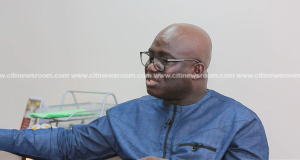The President of the Association of Ghana Industries (AGI), Dr Yaw Adu Gyamfi, has bemoaned the dwindling fortunes of the manufacturing subsector in recent years, warning that the country risks losing its industrial base should the situation remain the same.
Rather than inspiring entrepreneurs to build new factories and sustain existing ones to employ people and grow the economy, Dr Gyamfi said Ghana had, in the recent past, lost a chunk of its “once vibrant” areas of manufacturing to various challenges.
Addressing captains of industry and government officials at AGI’s Ghana Industry Awards on December 8, the president pointed to the phasing out of businesses in the textiles, alumina, vehicle assembly, glass manufacturing and those in the processing of agricultural products such as meat, sugar, tomatoes and citrus as evidence of a country which had its manufacturing base deteriorating rather than progressing.
“Industry continues to shrink and we risk losing our industrial base,” he said at the event which was graced by President Nana Addo Dankwa Akufo-Addo.
“On the occasion of our 60th anniversary, therefore, we are taking stock of developments in the industry over the past 60 years and I am sorry to say the picture of manufacturing has not been encouraging.
“We are actually deindustrialising,” Dr Gyamfi, who is also the Chief Executive Officer of Danadams Pharmaceutical Industry Limited, said at the event.
AGI, an advocacy body with over 400 members, has since its inception in 1958, become the voice of manufacturers and related businesses in the country.
How to reverse
On how to reverse the situation, the AGI said the country needed “a clear national strategy” on industrialisation.
“That is why we appreciate government initiatives such as the one district, one factory (1D1F), the stimulus package, and the other initiatives of the Ministry of Trade and Industry.
“We need to incorporate these initiatives into a comprehensive strategic plan in the form of an industrial policy that will drive the industrialisation agenda,” he said.
With the 2019 Budget Statement and Economic Policy keen on industry, the AGI president said: “we are anxious to see the impact on our industrialisation agenda.”
“Our prospects for job creation will improve if local industry experiences sustainable growth to alleviate the unemployment situation.
“Indeed, many of our school leavers spend longer times looking for jobs than the time they spent pursuing courses at their tertiary institutions.
This trend must change,” he said, pointing to a sustained revitalisation of manufacturing as a key relief.
Woes of manufacturing
For over a decade, manufacturing businesses have been at the mercy of cheap imports, pricey loans and erratic power supply which has led to a contraction and the collapse of some firms, loss of jobs and a consistent decline in the subsector’s contribution to national output.
Data computed and sourced from the Ghana Statistical Service (GSS) showed that from a share of 10.2 per cent in 2006, the contribution of the value addition arm of industry to gross domestic product (GDP) weakened consistently to a record low of 5.8 per cent in 2012 before wobbling further to 4.6 per cent in 2016.
At 4.5 per cent in 2017, the subsector’s share of GDP is now the lowest in 11 years and an anti-climax of an industrial revolution story that was virtually truncated in the late 1960, right after the overthrow of Dr Kwame Nkrumah.
Dr Gyamfi said while Ghana’s manufacturing subsector accounted for 4.5 per cent of GDP, the average was 22 per cent in middle income countries.
“Indeed, Ghana’s manufacturing value addition share to GDP has fallen since 1985, an indication of deindustrialisation,” he said.
In July this year, an Economist and Senior Research Fellow with the Institute for Fiscal Studies (IFS), Dr Said Boakye, told the GRAPHIC BUSINESS that the current state of manufacturing explained why the country was unable to achieve sustained development, also called prosperity in economics.
Source: Graphic.com.gh
 Public Agenda NewsPaper Ghana's only Advocacy & Development Newspaper
Public Agenda NewsPaper Ghana's only Advocacy & Development Newspaper






